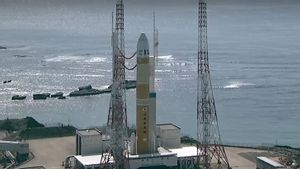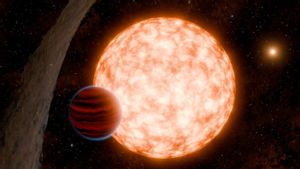JAKARTA - NASA's Solar Dynamics Observatory caught the Sun emitting a strong solar flare (class X), peaking at 12:52 a.m. EST on March 3, 2023.
The powerful X-class solar flare caused a temporary shortwave radio blackout over North and South America. The burst of energy, lasting seven minutes, was fired from a sunspot called AR 3234, located in the upper right region of the sun's surface.
It was first identified in February but has since quadrupled in size. According to SpaceWeather, pilots and radio operators may have a signal loss and other unusual propagation effects at frequencies below 30 MHz for up to one hour after the flare.
Solar radio bursts now reported by the US Air Force, suggest the explosion may also have generated a Coronal Mass Ejection (CME). CMEs are streams of high-energy, highly magnetic, and very hot gas released from the Sun.
CMEs can eject billions of tons of coronal material from the sun's surface. It consists of plasma and a magnetic field. Such eruptions have the potential to trigger space weather that can disrupt satellites and power grids on Earth and can be dangerous for unprotected astronauts.
SEE ALSO:
NASA reported its aircraft registered the flare as X2.1, part of a class that can trigger worldwide radio blackouts and long-lasting radiation storms in the upper atmosphere.
NASA states, its size can be up to 10 times the size of Earth, making it the largest type of flare. It rotates dozens of times the size of Earth jumping off the surface of the sun as the sun's magnetic fields cross each other and reconnect.
"In the biggest events, this reconnection process can generate as much energy as a billion hydrogen bombs. When the massive flare hits our planet, it interacts with the atmosphere and causes an outage that lasts up to 30 minutes. However, no significant problems occur as a result," said NASA.
NASA also reported a separate solar flare last month, which snapped off the sun's north pole. A video shows giant filaments of plasma, or electric gas, shooting out of the sun, separating and circulating in a massive polar vortex.
Scientists speculate that the advantage has something to do with the reversal of the sun's magnetic field which occurs once every solar cycle.
They haven't yet determined what causes the filaments in recent observations to revolve around the sun instead of flying off into space.
The recent increase in activity from the Sun results in the most active phase in the 11-year solar cycle, and will reach peak activity in 2024.
Research has shown the level of solar activity today is about the same as it was 11 years ago, at the same point in the last cycle. This was quoted from DailyMail, Tuesday, March 7.
The English, Chinese, Japanese, Arabic, and French versions are automatically generated by the AI. So there may still be inaccuracies in translating, please always see Indonesian as our main language. (system supported by DigitalSiber.id)


















